Exploring Baroque Rome
Rome presents its visitors with a unique opportunity to explore different periods of history and art in one place. Visit the Colosseum and the Roman Forum to discover the Ancient Rome, marvel at the Renaissance frescoes at Villa Farnesina or visit EUR for a glimpse of the modern Rome of Mussolini. But if you want to explore the legacy of one of the most prolific periods in Roman history, turn your attention to the city’s Baroque heritage.
Originated in Rome, the term ‘Baroque’ (from the Portuguese barocco, or ‘irregular pearl or stone’) describes a complex idea executed in intricate detail, an expressive style that dominated fine art during the period between 1590 - 1720 AD. Trying to reassert its power in the wake of the Protestant Reformation, the Catholic Church commissioned the best artists and architects of the period to create expressive and dramatic works of art, moving away from the idealism and serenity of the Renaissance. The centre of the Catholic world in the seventeenth century, Rome became the grand statement of the Pope’s power and majesty, expressed in all the arts.
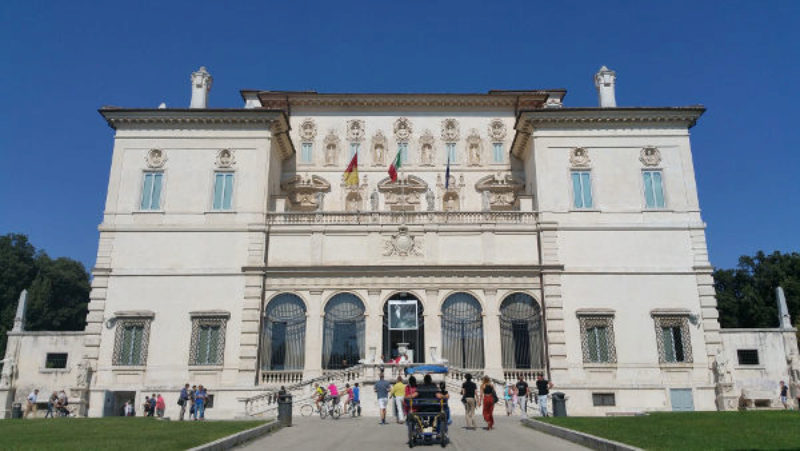
Borghese Gallery in Rome / Courtesy Wikipedia
We start our exploration of Roman Baroque from a beautiful park in the northern part of the city - Villa Borghese gardens. The third largest public park in Rome, it was the summer residence of the noble Borghese family, built in the early 1600’s. In 1605 it became one of Cardinal Scipione Borghese’s residences. The nephew of Camillo Borghese, newly elected Pope Paul V, Cardinal Borghese was a dedicated art collector and patron who amassed an exceptional collection of Baroque works of art, which is now open to public as the Borghese Gallery. One of the must-visit places in Rome, today the Borghese Gallery holds only a part of the original collection. In the early 1800s Prince Camillo Borghese was married into the Bonaparte family and had to give around 500 works from the collection to the Louvre in Paris, where they remain today.
Visit the Gallery to enjoy its exquisite interiors, sculptures by Bernini and Antonio Canova, and paintings by Titian, Raphael, and Caravaggio. The museum is open from Tuesday to Sunday from 8:30 a.m. to 7:30 p.m., and due to the venue’s size restrictions, tickets should be booked at least a week in advance.
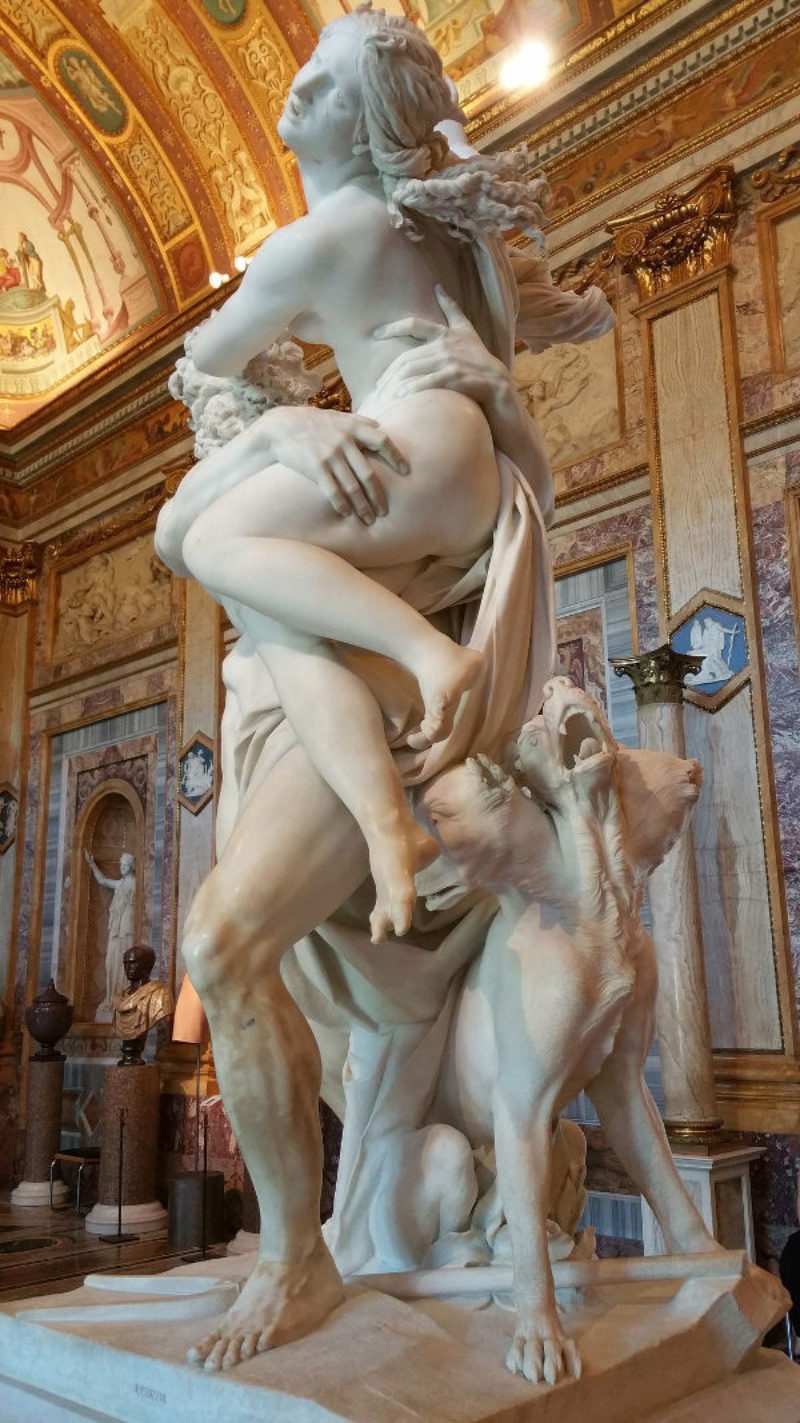
The Rape of Proserpina (1621 - 22) by Gian Lorenzo Bernini / Courtesy Wikipedia
Cardinal Scipione Borghese was a patron of Gian Lorenzo Bernini (1598 – 1680), one of the most prominent sculptors and architects of the seventeenth century. For this reason, the Gallery’s collection has some of the most striking examples of Bernini’s work, created between 1621 and 1625. Apollo and Daphne, The Rape of Proserpina, and David are brilliant examples of the Baroque period, showcasing how the period’s artists took marble’s expressiveness to new heights. Developing upon Michelangelo’s fascination with the human body, Bernini added torsion to create dynamic figures that extends into the viewer’s space. Spend some time going around his sculptures to admire the extraordinary level of detail and emotional embodiment of mythological and Biblical stories.
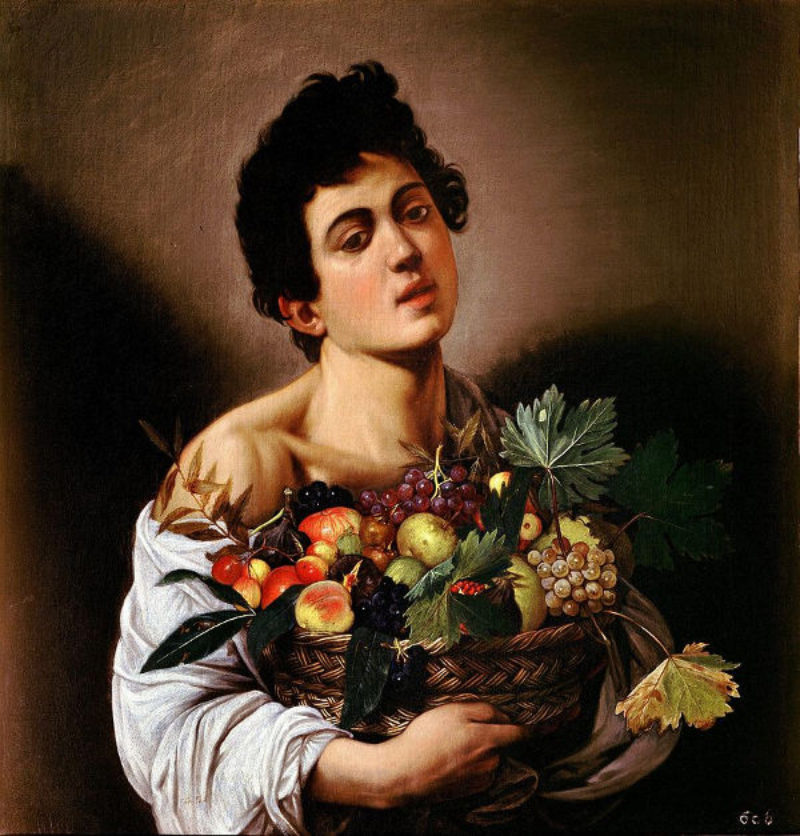
Boy with a Basket of Fruit (1593) by Caravaggio / Courtesy Wikipedia
Another important Baroque master in the Borghese collection is Michelangelo Merisi da Caravaggio (1571–1610). The Borghese Gallery has perhaps the best collection of Caravaggio’s works, including the Young Sick Bacchus (c. 1593), Madonna and Child with St. Anne (1605-1606), Saint Jerome Writing (1605-1606), and David with the Head of Goliath (1610).
Originally from the area around Milan, Caravaggio arrived in Rome in the 1590s. Boy with a Basket of Fruit (c. 1593) is perhaps one of his most important early Roman works, now on view at the gallery. This frequently reproduced work is Caravaggio’s earliest attempt to depict the subject realistically rather than idealising it, as was common in painting before. Here he started his practice of inviting real people to be his models and employed a dramatic use of light and shadow.
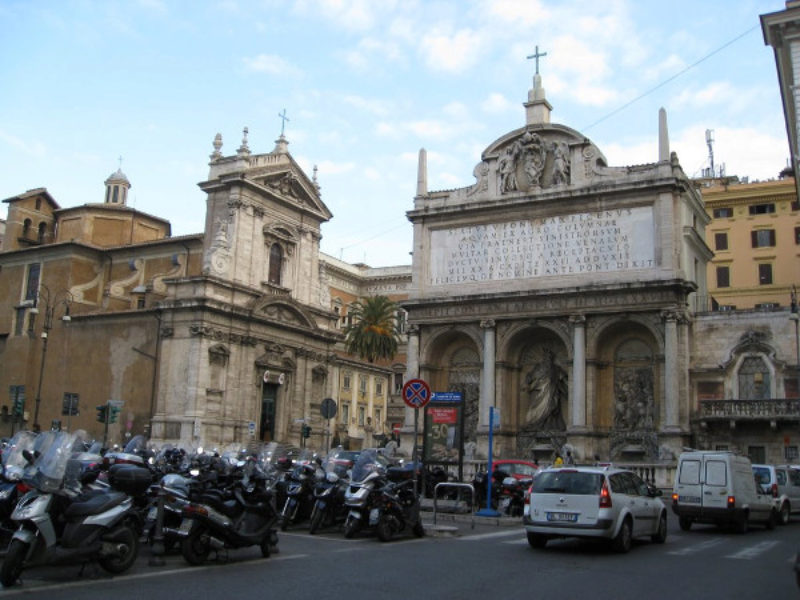
Chiesa di Santa Maria della Vittoria / Courtesy Wikipedia
Leave the Villa Borghese gardens and turn right onto Via Pinciana, then turn left to Via Giacomo Puccini and continue along Via Piemonte. A short walk will bring you to Via Venti Settembre. Don’t be intimidated by the grandeur of Domenico Fontana’s Fountain of Moses (1585), our next stop is Chiesa di Santa Maria della Vittoria just across the street.
Completed in 1626, the church is another example of Cardinal Scipione Borghese’s patronage. The façade was designed by Giovanni Battista Soria, who was influenced by Carlo Maderno’s façade on the church of Santa Susanna, located to the left across the road.
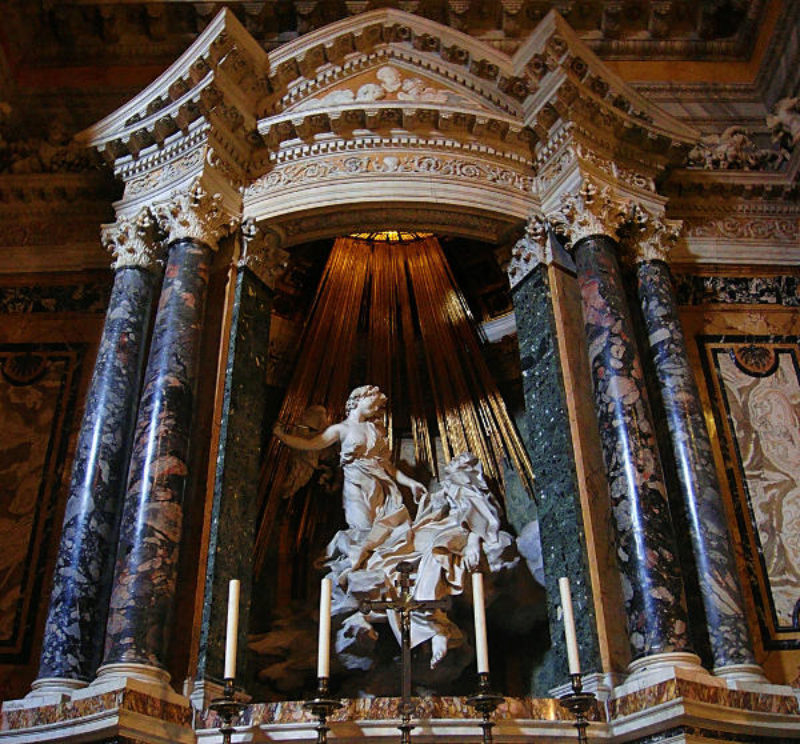
The Ecstasy of Saint Teresa (1647 - 52) by Gian Lorenzo Bernini / Courtesy Wikipedia
The rather simple façade of this church conceals its luxurious interior, decorated with contrasting marble with white and gilded stucco angels in relief. Walk along the nave to the Cornaro Chapel, the last one on the left side of the altar, to discover the main attraction of the church - The Ecstasy of Saint Teresa (1647–52) by Bernini. The statue depicts a moment from Saint Teresa of Avila’s autobiography, where she describes the vision of an archangel piercing her heart with a golden shaft, causing her both immense joy and pain.
Here Bernini engages sculpture, architectural elements, and hidden light sources to turn the family chapel into a theatrical recreation of Saint Teresa of Avila’s story, also using the flowing robes and twisted posture to convey a passionate religious trance. The theatricality of the design is increased by the two opera box-like elements on the walls of the chapel, with sculptural representations of members of the Cornaro family.
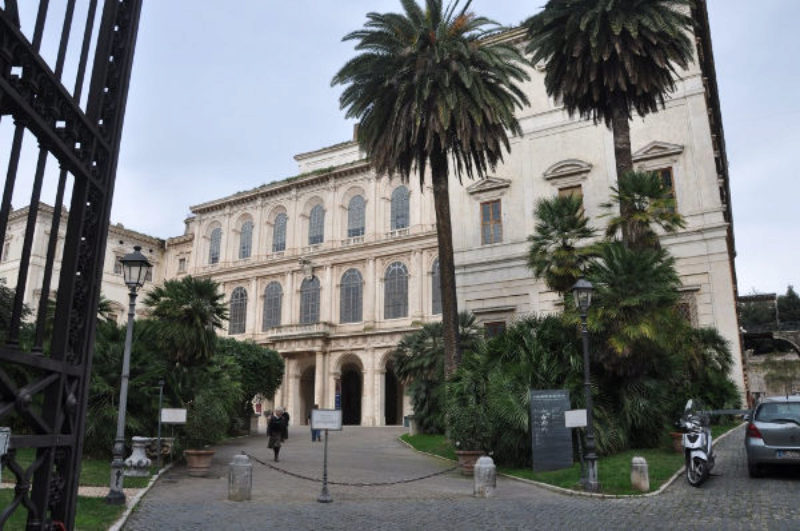
Palazzo Barberini in Rome / Courtesy Wikipedia
Continue your journey along Via Venti Settembre and turn to Via delle Quattro Fontane. In front of you is another example of a Baroque palace, which at first sight does not come across like one.
The Palazzo Barberini was designed for Pope Urban VIII, a member of the Barberini family, by architect Carlo Maderno (1556 – 1629), and was completed by Bernini and his competitor, Francesco Borromini (1599 – 1667), who was another great Baroque architect. Now the palace is one of the sites of National Gallery of Ancient Art , along with the Palazzo Corsini. Open from Tuesday to Sunday from 8:30am to 7 pm, this museum holds a great collection of Old Masters, including Caravaggio, Titian and Raphael.
But before entering the museum to enjoy its collection, continue your way through the central gates of the palace and you will find yourself in a fine Italian garden, recently restored to its original design.
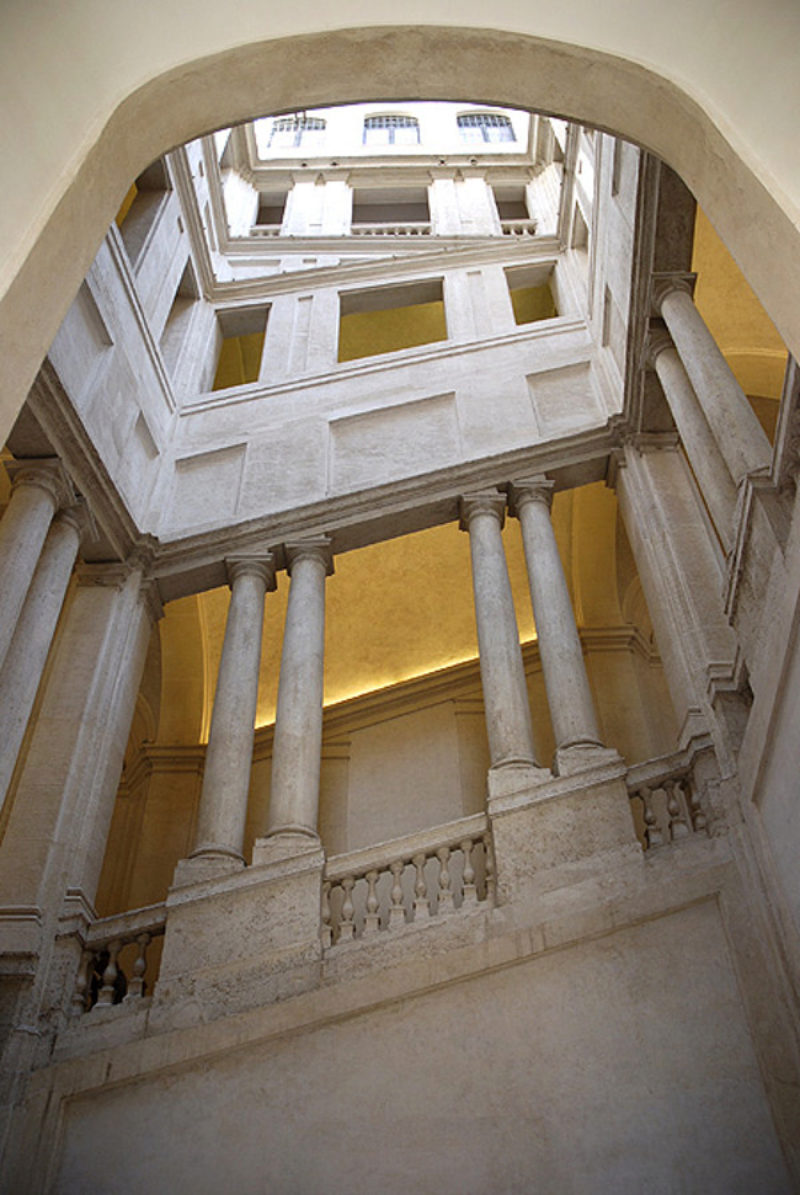
Borromini Staircase in Palazzo Barberini in Rome / Courtesy Wikipedia
Explore the main entrance to the museum to learn about one of the most famous rivalries in the history of art - Bernini vs Borromini. Their different approaches to architecture start with their contrasting personalities. Bernini was well connected with papal families and art patrons in Rome, and was charming and popular. Borromini in turn had a difficult character, and was regarded as antisocial and stubborn.
The staircases at the Barberini Palace, the result of a collaboration between Bernini and Borromini, are a great place to compare the contrasting styles of the two artists. To the left you will find the one designed by Bernini, who treated architecture as a calculated staging experience, and used theatricality and drama in his designs to heighten the visitor’s emotional and spiritual response.
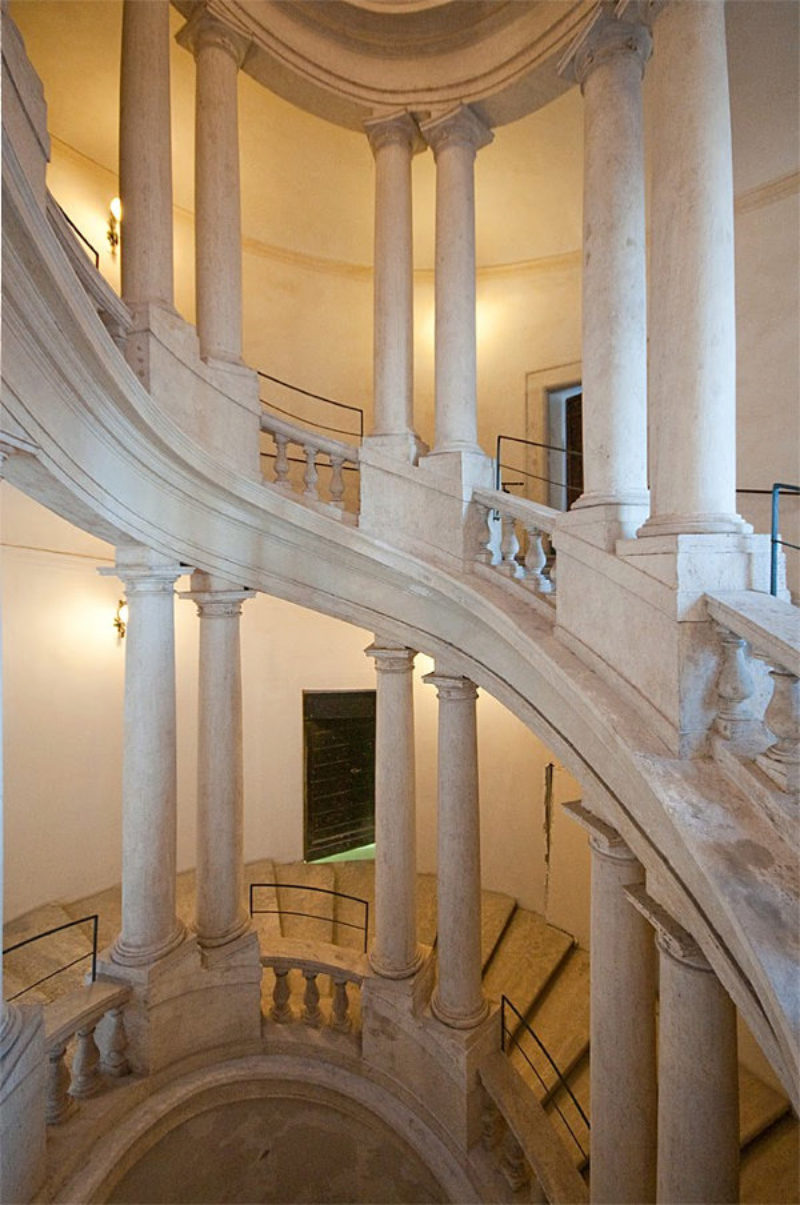
Bernini Staircase in Palazzo Barberini in Rome / Courtesy Wikipedia
On the right side of the building is Borromini’s staircase, and it could not be more different. Contrary to Bernini, Borromini was confident in his ambition to break the rules of classical architecture, so popular during the Renaissance. In this staircase, he distorted and elongated pure classical elements, creating dynamic spaces influenced by organic shapes.
These two different approaches to architectural design clearly reflected two different visions of Baroque architecture, examples of which we will see further on our way.
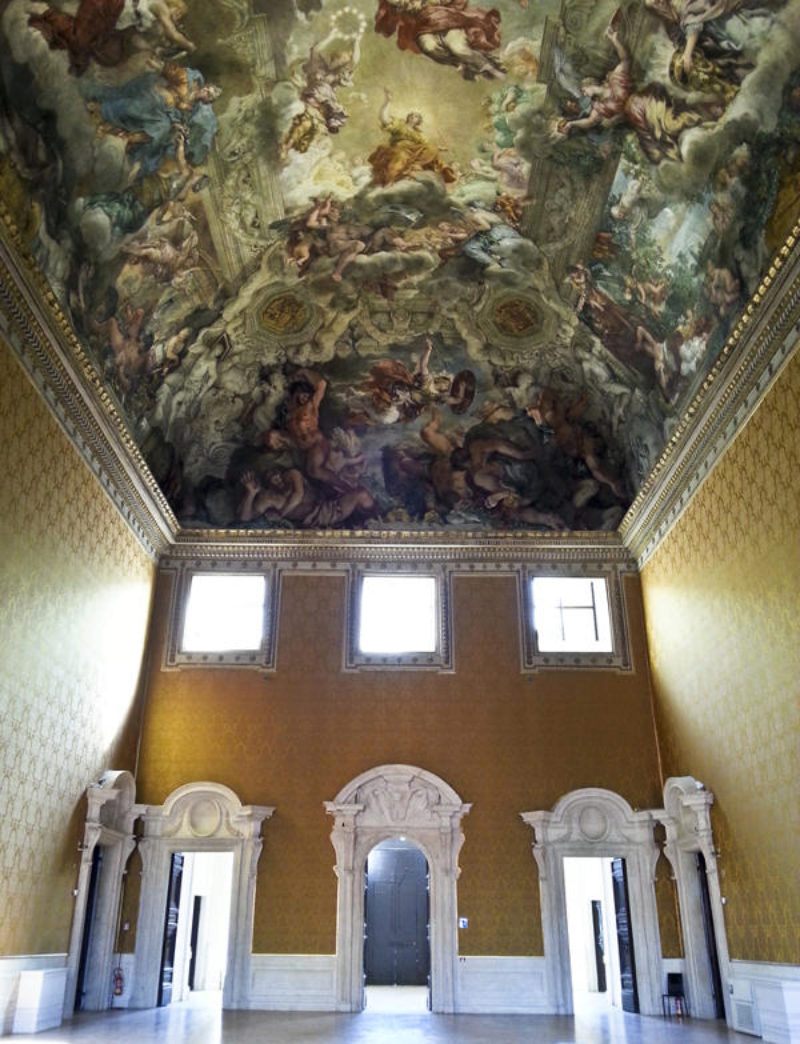
The Allegory of Divine Providence (1633-39) by Pietro da Cortona / Courtesy Wikipedia
Once you are inside the museum, be ready to be amazed by one of the most impressive pieces of papal propaganda. The largest secular fresco of the Roman Baroque, The Allegory of Divine Providence (1633-39) by Pietro da Cortona (1596 - 1669) dominates the ceiling of the Sala dei palafrenieri, or the Grand Salon, which was the central public reception room of the Barberini Palace. Commissioned by Maffeo Barberini, then Pope Urban VIII, the Allegory celebrates the power of the Barberini family.
Opening up the ceiling to the sky, the fresco is a masterpiece of illusionistic ceiling painting. Filled with symbols and references, it prominently features three bees - the symbol of the Barberini family. The flying maidens and cherubs on one side of the sky are holding the papal keys and tiara, while the other side is occupied by the figure of the solar Divine Providence, which supposedly refers to the idea that the election of Maffeo Barberini as the Pope was predestined by divine providence.
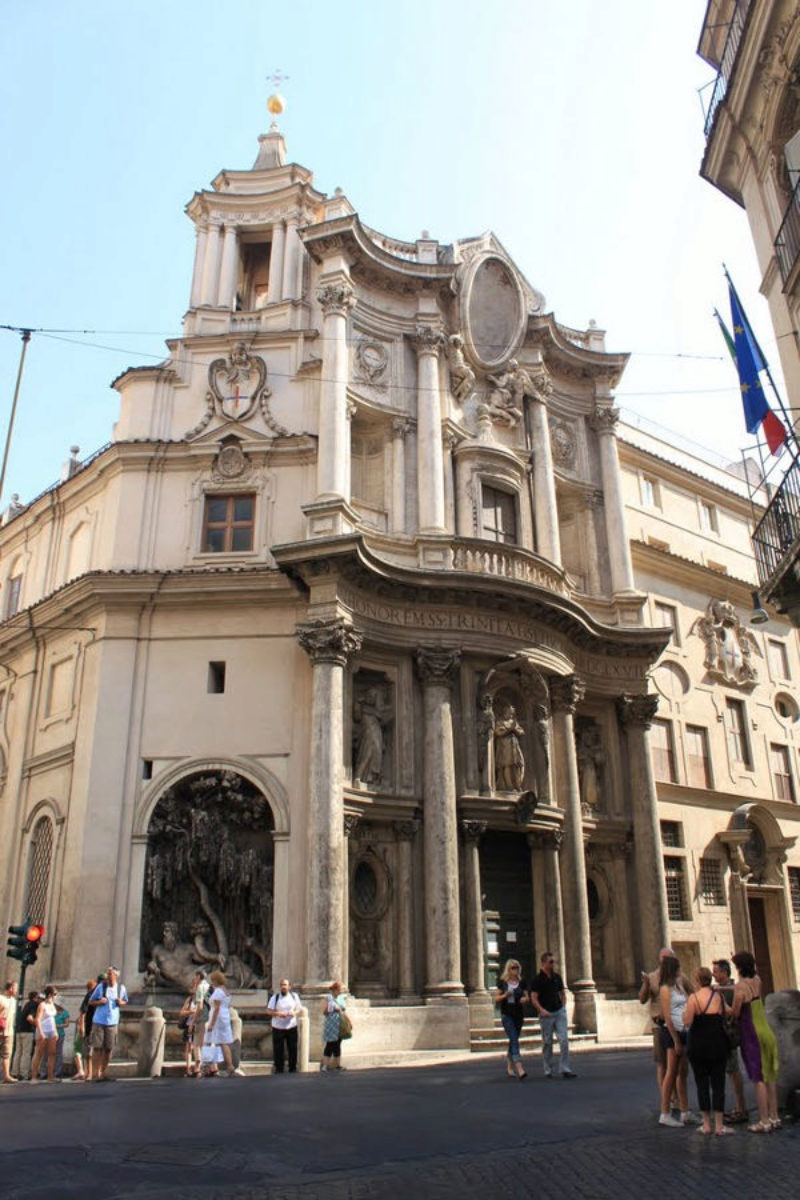
San Carlo alle Quattro Fontane / Courtesy Wikipedia
Continue your way along Via Quattro Fontane to reach our next stop - San Carlo alle Quattro Fontane. Located on a small square with four fountains at each corner, the church reflects an important development of Baroque Rome - urban planning with new straight streets cutting through existing quarters.
The first independent commission executed by Borromini, the church’s construction was initially sponsored by the Barberini family, who later abandoned their patronage. The Trinitarian monks, who owned the land, did not have enough money to pay Borromini, but instead granted to the architect full artistic freedom, thus making the church a quintessential example of his artistic genius.
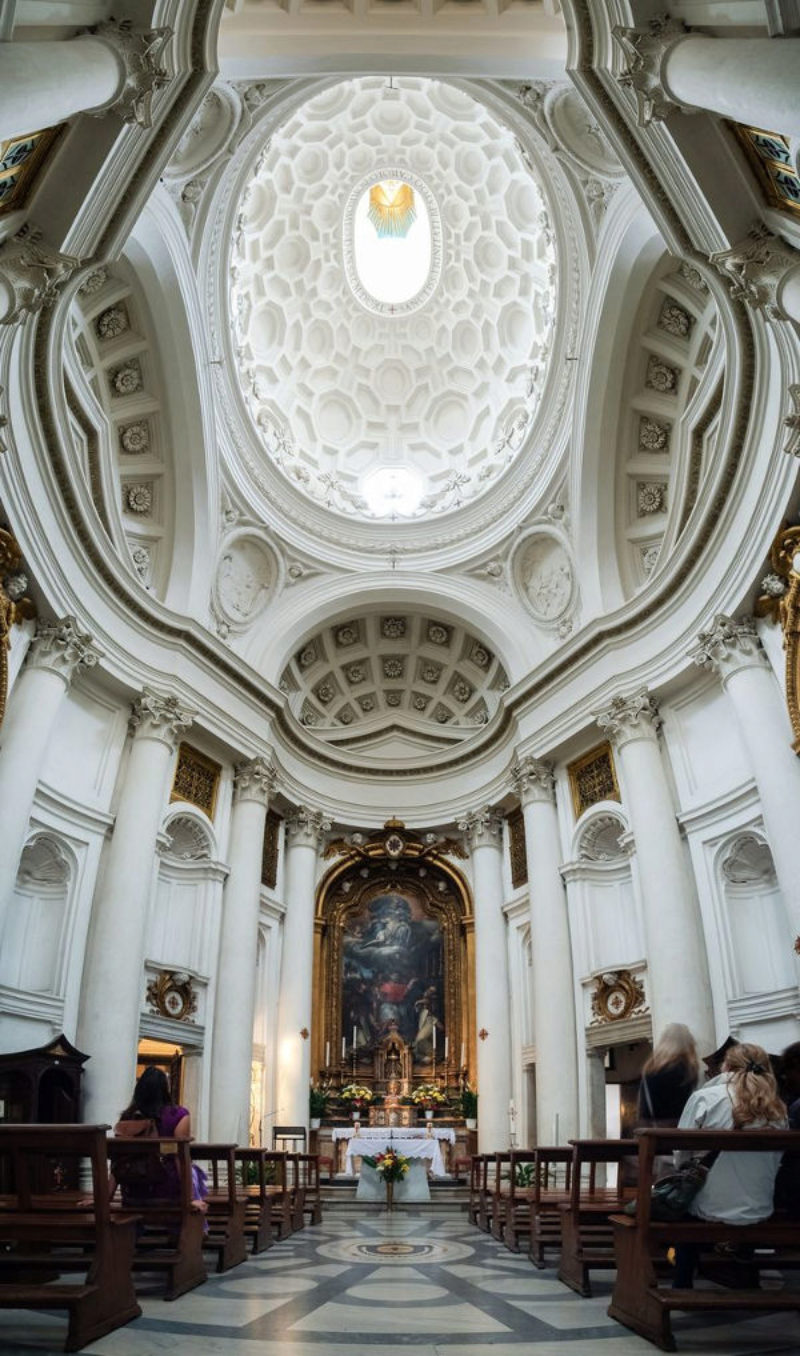
Interior of San Carlo alle Quattro Fontane / Courtesy Wikipedia
Despite the irregular shape of the site, Borromini was able to create a masterpiece of Baroque architecture. Through a series of manipulations and distortions of two elemental geometric shapes—the circle and the triangle—Borromini designed the plan of San Carlo as an ellipse with the entrance and the high altar at opposite ends of the long axis. To design this oval shape, Borromini placed two equilateral triangles side by side and drew circles in each of them to create the outer curve of the ellipse. Using these two basic elements, Borromini not only showed his love of geometry and proportion, but also his devotion to Christian symbolism: the triangle represents the holy trinity and the circle represents the eternity of God. A similar idea is reflected on the top of the dome, where a dove—the symbol of the Holy Spirit—is enclosed in a triangle surrounded by a circle.
Contrary to other Baroque churches, Borromini created his spaces with an emphasis on architectural geometry, using little decoration. Painting the walls of the church in white, he wanted to astonish the visitors by the complexity of architecture in its pure form.
Despite the ingenuity of San Carlo alle Quattro Fontane, after its completion Borromini fell out of popularity under Alexander VII’s papacy, leaving the stage to his lifelong rival, Gian Lorenzo Bernini. His fame was growing at the time, and our next stop will present an opportunity to explore Bernini’s artistic ideas and compare them to Borromini’s.
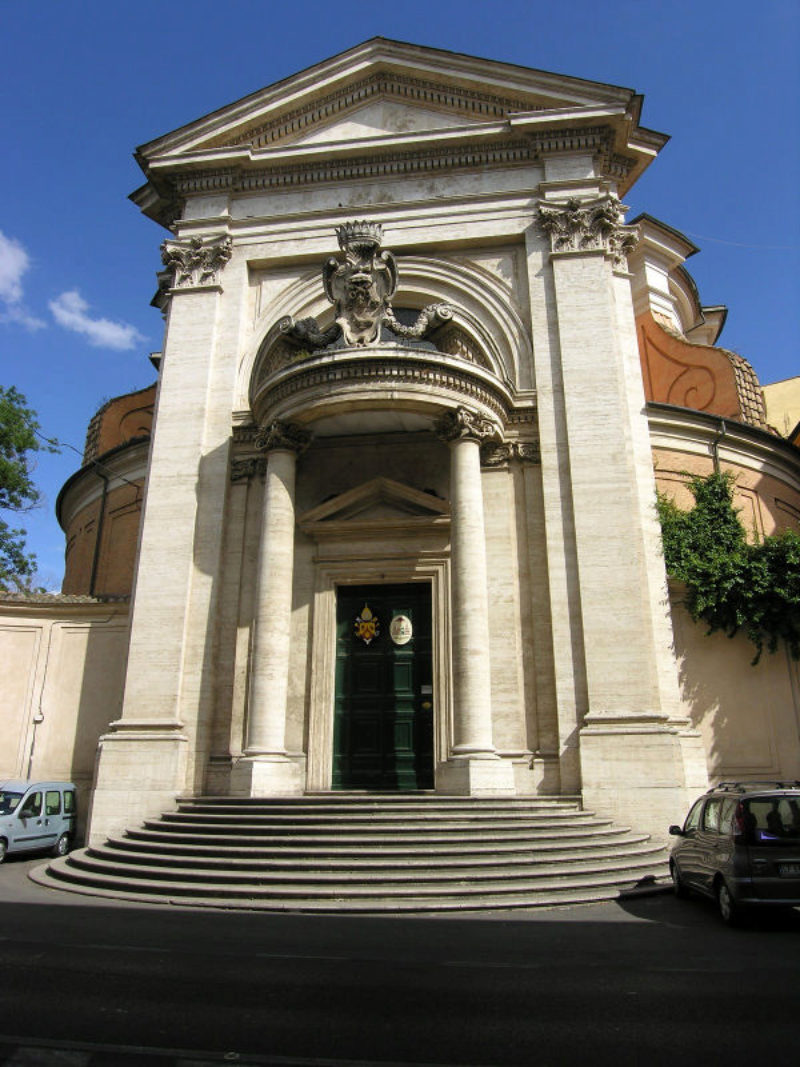
San Andrea al Quirinale / Courtesy Wikipedia
San Andrea al Quirinale is conveniently located just five minutes away from San Carlo alle Quattro Fontane, on Via del Quirinale. Bernini received the commission to build this Jesuit church in 1658, and it was completed by 1672. Its façade is strikingly different from surrounding Renaissance buildings. Playing with concave and convex forms, Bernini creates a dynamic, inviting entrance to the world of God with the semi-circular portico. This truly Baroque feature gives a hint of the theatricality that a visitor can expect from the interior of the church.
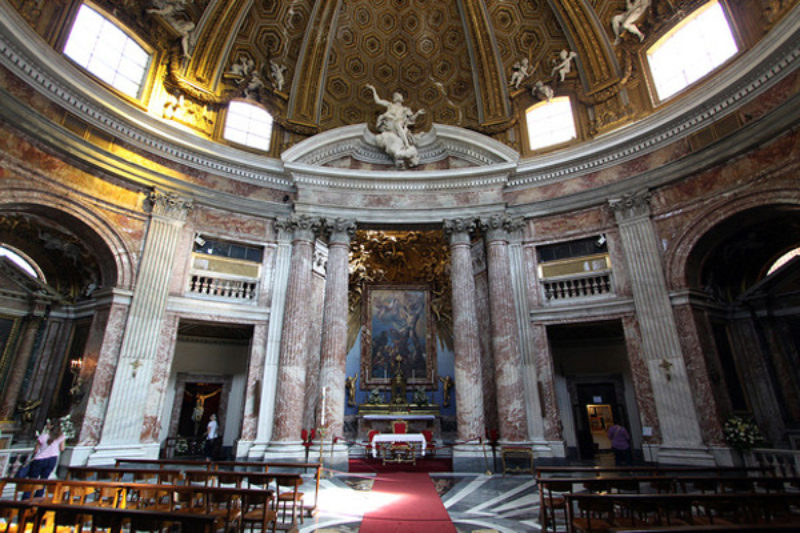
Interior of San Andrea al Quirinale / Courtesy Wikipedia
Once inside the church, you are overwhelmed by the theatricality of the interior. Here Bernini was also given full creative freedom, but while Borromini amazes the visitor with the architecture only, Bernini combines architecture, sculpture, painting, and dramatic lightning to showcase the glory of God. The church was built at the height of the Counter Reformation in Rome, when Catholics were trying to bring people back to the church, and the artist successfully achieves the goal of making it an attractive place.
On contrary to Borromini’s San Carlo, Bernini left the oval shape of the site in place, and brought together brightly coloured marble, gold, and plaster to create the splendid interior. Placing the altar on the short axis of the oval, Bernini makes the visitor walk around the church to fully experience the space, which was an important aspect of Baroque design. Notice the depiction of the martyrdom of Saint Andrew, the namesake of the church, at the high altar. Looking up, the saint in the painting directs your eye towards Bernini’s sculpture of the saint’s spirit, ascending into heaven. The dramatic effect is even more powerful due to the sculpturally rendered rays of sunlight, which are brought to life by the natural light coming from the hidden window over the altar.
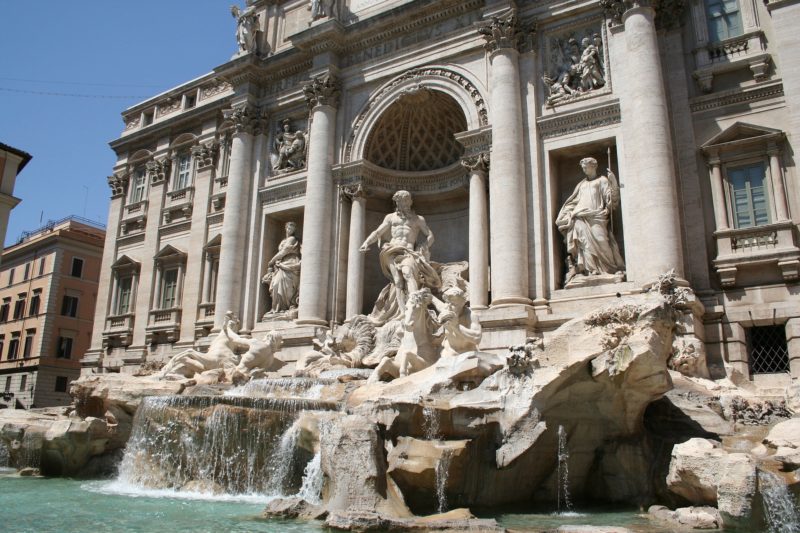
Trevi Fountain / Courtesy Wikipedia
Go down the Quirinal Hill to see how Bernini’s flamboyant style influenced artists many years later. Completed in 1762, the Trevi Fountain is strictly speaking not a creation of the Baroque era, but it certainly combines the histrionics and dramatism so cherished by the creatives of that period. One of the most famous fountains in the world, it dates back to the Ancient Rome, but its design was not considered dramatic enough in the 1620s. Pope Urban VIII commissioned the fountain’s redesign to Bernini, but his project was never executed. The current version was designed by Italian architect Nicola Salvi (1697 – 1751) and completed by Pietro Bracci (1700–1773). Throw a coin to the swirling waters of the fountain to secure your return to Rome.
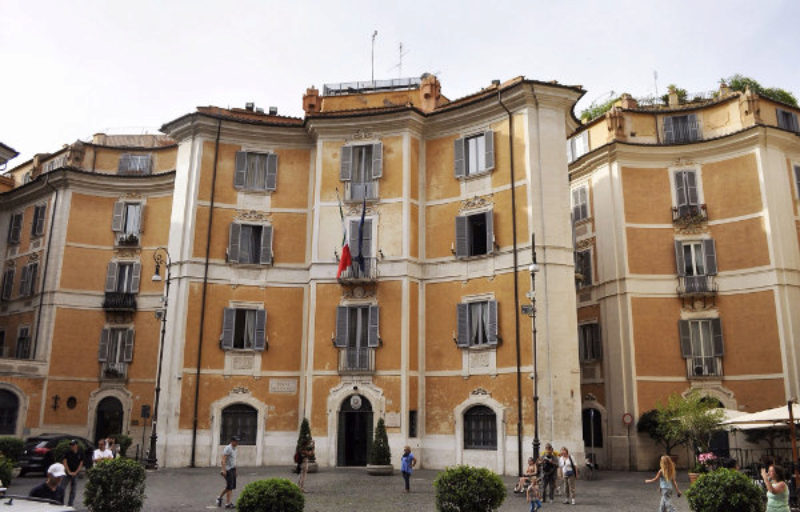
Piazza di Sant’Ignazio / Courtesy Wikipedia
Our next stop, Chiesa di Sant’Ignazio di Loyola, is a five-minute walk from the fountain along Via delle Muratte. Dedicated to Ignatius of Loyola, the founder of the Society of Jesus, it was built between 1626 and 1685, with the Baroque façade designed by Carlo Moderno. Originally opened in the 1550s as a church to the Roman College, a free public educational institution, it was extended in the mid-17th century. The square in front of the church creates an illusion of a theatre stage, following the ideas of the Baroque.
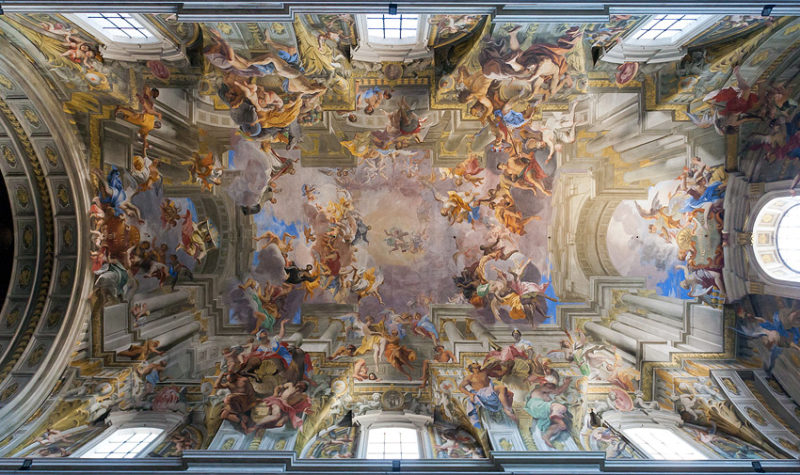
The Apotheosis of St Ignatius (1688-94) by Andrea Pozzo / Courtesy Wikipedia
The luxurious interior of the church, embellished with gold and coloured marble, is yet another example of a grandiose Baroque decoration, but the main attraction here is the ceiling. Painted by Andrea Pozzo (1642 – 1709), a Jesuit lay brother, it is rightfully considered a masterpiece of the High Roman Baroque and possibly the greatest example of so-called ‘quadratura’. In fine arts, this term is strongly associated with the Baroque era and used to describe a form of illusionistic mural painting, where architectural features are painted onto walls or ceilings to create an illusion of real architecture and an imaginary space beyond the actual wall or ceiling.
Here Pozzo executed The Apotheosis of St Ignatius (1688-94), the grandiose fresco that covers the nave ceiling. Celebrating the work of Saint Ignatius and the Society of Jesus, it depicts the saint entering paradise, welcomed by Christ and the Virgin Mary and surrounded by allegorical representations of all four continents, discovered at that time. Pozzo ‘breaks’ the nave’s vault, opening it up to the bright sky and filling it with floating figures. Look for a yellow marble disk in the middle of the nave’s floor to get the best view of the fresco.
The initial plan for the church’s extension proposed a grand dome. However, due to lack of funds, it was never executed. It in turn served as an inspiration for Pozzo’s ingenious solution to the missing dome. He decided to cover the void with a so-called ‘trompe l’oeil’ (illusionistic oil painting), depicting the proposed dome’s interior. This illusionistic image is 17 meters in diameter and still amazes visitors today just as it did in the seventeenth century. Stand on the marble disc closer to the altar to appreciate the illusion in full.
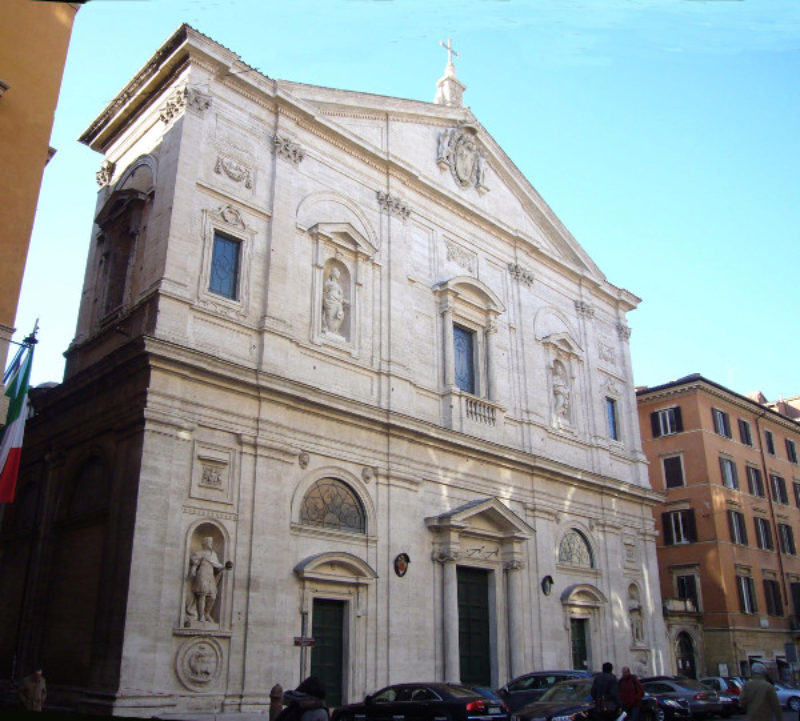
San Luigi dei Francesi / Courtesy Wikipedia
Our next stop is San Luigi dei Francesi, the church of the French community in Rome, commissioned by Cardinal Giulio di Giuliano de’ Medici (later to became Pope Clement VII) in 1518, but finished only in 1589 due to a military conflict. The church is dedicated to the patron saint of France, King Louis IX, and received donations from numerous French kings, including Henry II, Henry III, and the latter’s mother, Catherine de’ Medici.
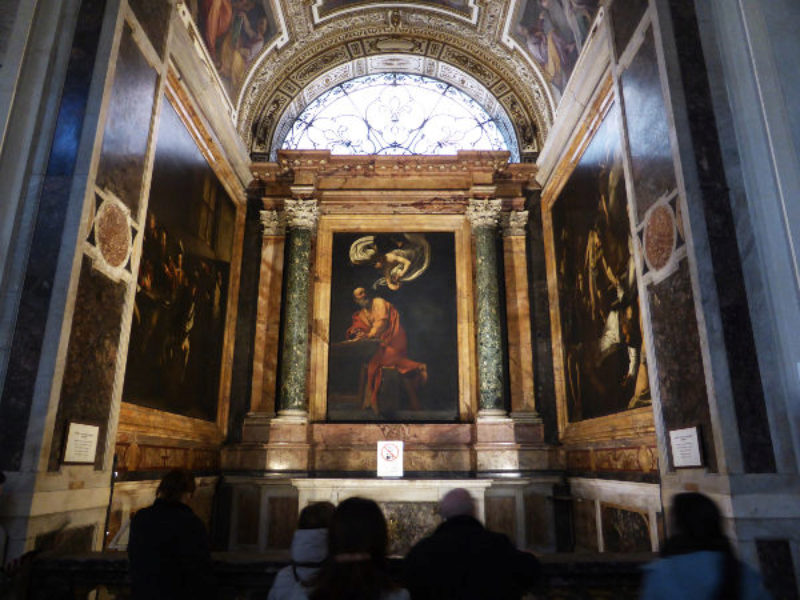
The Contarelli Chapel in San Luigi dei Francesi / Courtesy Wikipedia
Decorated by several prominent Italian masters, the church’s most famous treasure is the cycle of paintings in the Contarelli Chapel, painted by Caravaggio in 1599-1600. Referencing the life of Saint Matthew, it includes the three canvases of The Calling of St Matthew (on the left wall), The Inspiration of Saint Matthew (above the altar), and The Martyrdom of Saint Matthew (on the right wall).
The commission to decorate the chapel—dedicated to the French Cardinal Matteu Contreil (in Italian, Matteo Contarelli)—was initially given to the Italian artist Cavalier D’Arpino, with Caravaggio working as his apprentice. However, D’Arpino became too busy and the work was given to Caravaggio, most likely with the help of his patron, Cardinal Francesco Maria del Monte, one of the leading art connoisseurs and collectors in Rome. He lived around the corner from the church, at Palazzo Madama, and noticed Caravaggio when he was one of the many painters selling his works at Piazza Navona.
Caravaggio was already famous for his naturalistic depictions of people and fruits in his works, and he developed his skill even further. With the help of tenebrism (the use of dark tones and shadows in painting), Caravaggio created dramatic depictions of Biblical scenes. To make his works look even more impressive, Caravaggio depicted the light in each painting to be consistent with the actual illumination inside the chapel. While highly controversial to his contemporaries from the visual point of view, these works immediately made Caravaggio one of the most famous painters in Baroque Rome, and continue influencing artists today.
If you would like to see more works by Caravaggio, take a slight detour to the church of Sant’Agostino around the corner to see The Madonna of Loreto of 1604–1606.
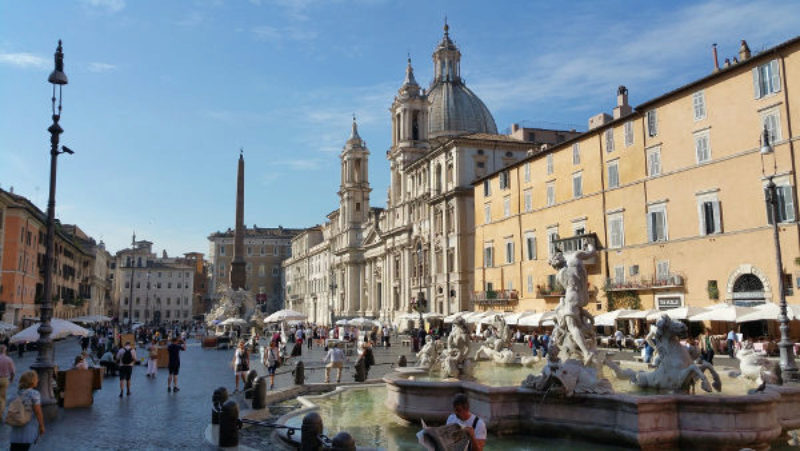
Piazza Navona / Courtesy Wikipedia
Two minutes away from San Luigi dei Francesi is one of the most important squares in Rome – Piazza Navona. Built on the site of the Stadium of Domitian (1st century AD), it keeps the elongated shape of the stadium, where the ancient Romans came to watch the agones (‘games’). Eventually this word was transformed into ‘navona’, giving the square its current name.
From 1644 to 1655, during the pontificate of Innocent X, whose family palace, the Palazzo Pamphili, faces the square, Piazza Navona became a significant example of Baroque Roman architecture and art. The central place is occupied by the magnificent Fontana dei Quattro Fiumi or Fountain of the Four Rivers, designed by Bernini in 1651, with the Egyptian obelisk in the centre. The fountain’s composition with the four major rivers represents the four continents through which papal authority had spread: the Nile for Africa, the Danube for Europe, the Ganges for Asia, and the Río de la Plata for the Americas.
The facades of the church of Sant’Agnese in Agone and the Palazzo Pamphili on the square were designed by Borromini, who worked here together with several of his contemporaries.
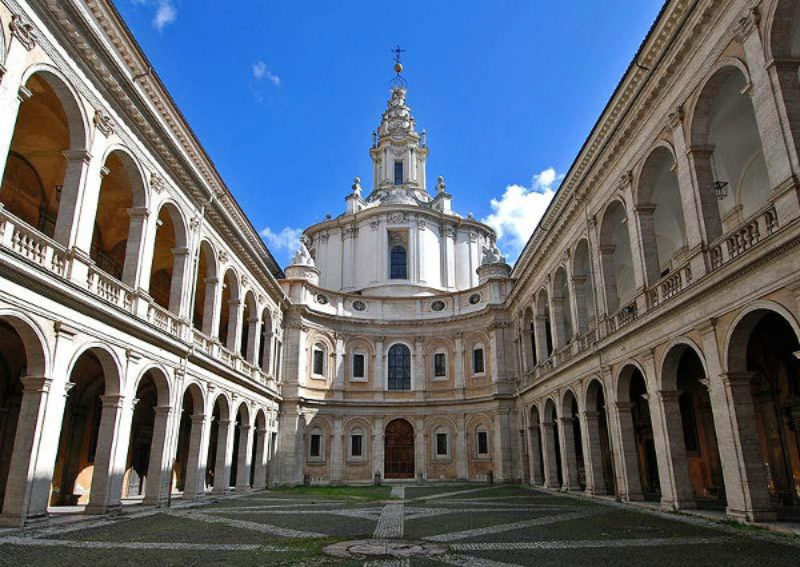
Sant'Ivo alla Sapienza / Courtesy Wikipedia
Hidden behind the walls of the Archives of the City of Rome at Corso del Rinascimento, 40, Sant’Ivo alla Sapienza is another great example of Borromini’s architectural genius. Until 1935 this place, the Palazzo della Sapienza (‘house of knowledge’), was the seat of the University of Rome, founded in 1303. The unified structure of the palace was designed by the architect Giacomo Della (c. 1533 – 1602) in the 1500s, but was not completed because of his death. Only thirty years later, in 1632 the Barberini Pope, Urban VIII, commissioned Borromini to complete the project and turn the university’s 14th century chapel at the end of a narrow courtyard into a proper church.
Before going inside the church, have a look at its unique spire, also designed by Borromini. Shaped as a spiral staircase, it led to many interpretations: some think it is a representation of the ‘fire of knowledge’ or the Tower of Babel, drawings of which Borromini kept in his study, while others see the stinger of a bee, which was the symbol of the Barberini, Urban VIII’s family.
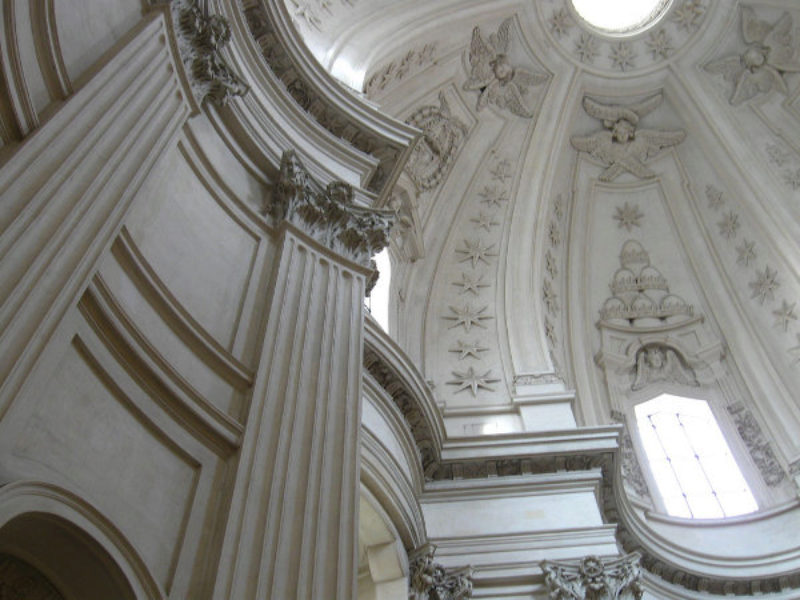
Interior of Sant'Ivo alla Sapienza / Courtesy Wikipedia
Enter the church and you will see Borromini’s signature style, similar to San Carlo alle Quattro Fontane. The interior is all white, allowing the intricacies of the architecture to shine through the play of the convex and concave surfaces. Working again with a site of a small size and irregular shape, Borromini superimposes two triangles to form the Star of David. Placing the circles on alternating points of the star, the architect rounded them off to become either convex or concave surfaces.
If you want to explore the interior of the church, you need to plan ahead: it is opened on Sunday mornings only, from 9.00 to 12.00, and remains closed in July and August.
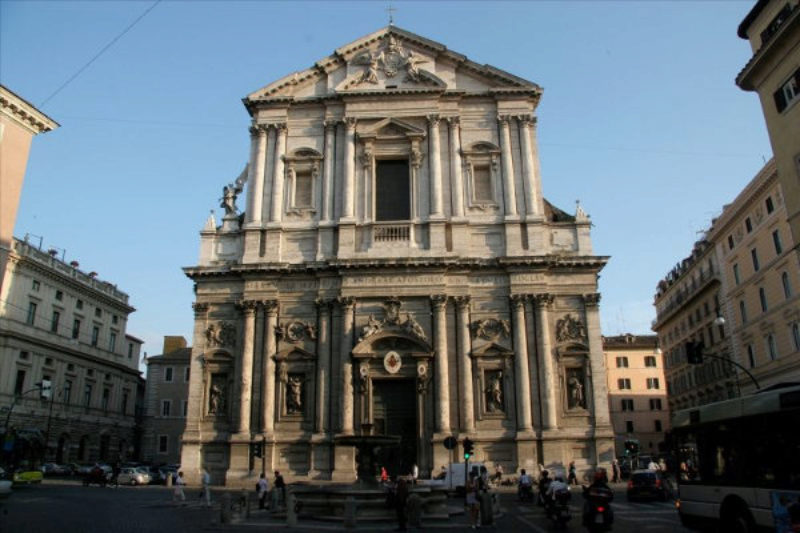
Sant’Andrea della Valle / Courtesy Wikipedia
Leave the Palazzo della Sapienza back to Corso del Rinascimento and in five minutes you will reach Sant’Andrea della Valle, another important Baroque church, which appeared in the opening act of Puccini’s Tosca.
The original site of the church was bequeathed in 1582 by Donna Costanza Piccolomini d’Aragona, the Duchess of Amalfi, to the newly formed Theatines order. In her will she requested the order to build there the church to Saint Andrew, patron saint of Amalfi. The order did not have enough funds to proceed with the construction, and only in 1608 they finally found their benefactor, Cardinal Alessandro Peretti di Montalto, Pope Sixtus V’s nephew. The Cardinal commissioned the construction to Carlo Moderno, one of the most sought after architects of the time, who in turn invited Borromini to collaborate. Finished only after Moderno’s death, in 1650, the façade is more three dimensional than those of earlier Baroque churches, with the use of columns instead of pilasters (flattened columns) and varying planes.
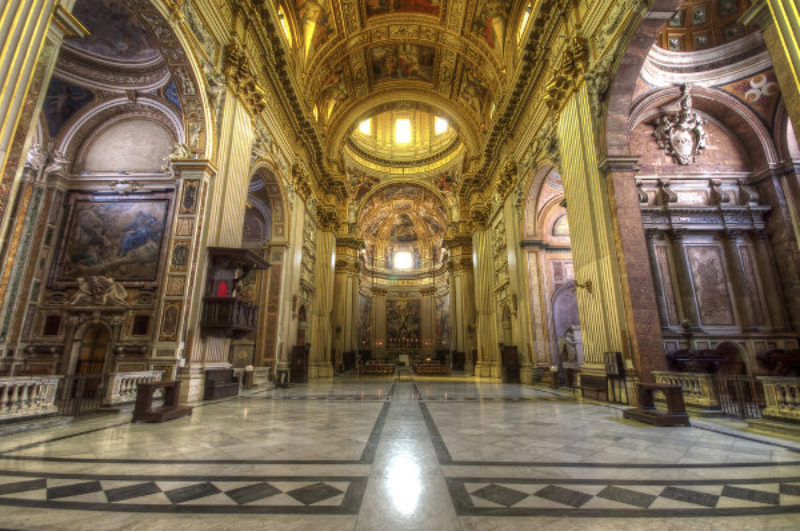
Interior of Sant’Andrea della Valle / Courtesy Wikipedia
Entering the church, be ready to be dazzled by the abundance of gold and marble decorations in the interior. The nave ceiling covered in frescoes and the ornate side chapels are lit up by the natural light from numerous windows in chapels, the vault, and the dome, making the opulent interior appear weightless.
Every chapel of the church has something to offer to a curious visitor. The Strozzi chapel, the second one on the right, was probably designed by Michelangelo and has bronze copies of his Pietà (from Saint Peter’s). It is also decorated with amazing stonework of the finest marbles and semi-precious stones. The Chapel of Saint Andrew houses frescoes by Giovanni Lanfranco (1582 –1647): Saint Andrew Avellino and Death of the Saint, and the cupola of this chapel is covered by the fresco Glory of Paradise by Domenichino (1581 –1641).
Another work by Lanfranco, The Celestial Glory, adorns the inside of the church’s dome, which is the second largest in Rome after St Peter’s. The artist won this commission from his rival Domenichino, which almost led to a duel between the two. In the end Domenichino was commissioned to paint Saints Matthew, Mark, Luke, and John on the pendentives supporting the dome, and the frescoes on the life and martyrdom of Saint Andrew in the apse area behind the altar.
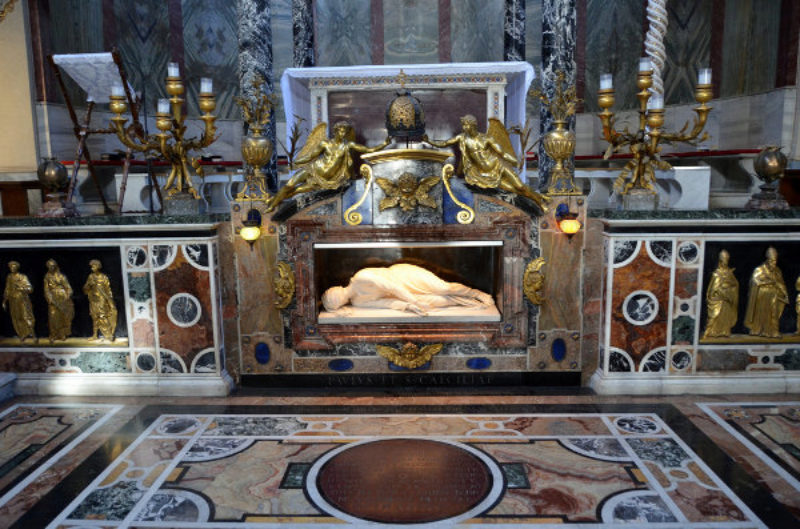
Sculpture of Santa Cecilia (1599) by Stefano Moderno / Courtesy Wikipedia
To get to our next stop we will need to cross the Tiber river and reach the Trastevere neighbourhood. Located in the less touristy area of the district, the church of Santa Cecilia in Trastevere houses a striking example of early Baroque sculpture.
Cecilia is one the most popular Roman saints, who probably lived between 175 to 250 AD, and one of the first legends about her was written in the middle of the 5th century. Coming from a noble family, Cecilia took a vow of virginity and dedicated her life to God. Despite her decision, Cecilia’s parents married her off to Valerian of Trastevere. On their wedding night, she persuaded her husband to be baptised, and together with his brother and some friends Valerian began a Christian ministry of giving alms to the poor only to eventually become martyrs for refusing Roman gods. Cecilia was also prosecuted. After several attempts to kill her, a soldier attempted to behead her with an axe, but her severed head miraculously remained alive for another three days.
The present church was built over the ruins of Cecilia’s house in the 5th century, and the bodies of the saint together with those of Valerian and others were exhumed and reburied in the church. The legend says that Cecilia’s body was found incorrupt at the moment of exhumation. It happened again in 1599, during the restoration of the church, which was confirmed by several witnesses, including Stefano Moderno (1576 – 1636), an Italian sculptor. Struck by the miraculous discovery of the incorrupt body, Moderno carved a naturalistic representation of Cecilia with three cuts in her neck, exactly as she was exhumed in 1599. The statement, carved in the marble floor in front of the statue, is Moderno’s personal witness account of the discovery in 1599.
Created at the turn of the century, this sculpture could be described as proto-Baroque with its interest in naturalistic depiction and dramatic effect of the saint’s pose. You could compare it to an example of the High Baroque sculpture by Bernini, which can be found at our last destination, the church of San Francesco a Ripa.
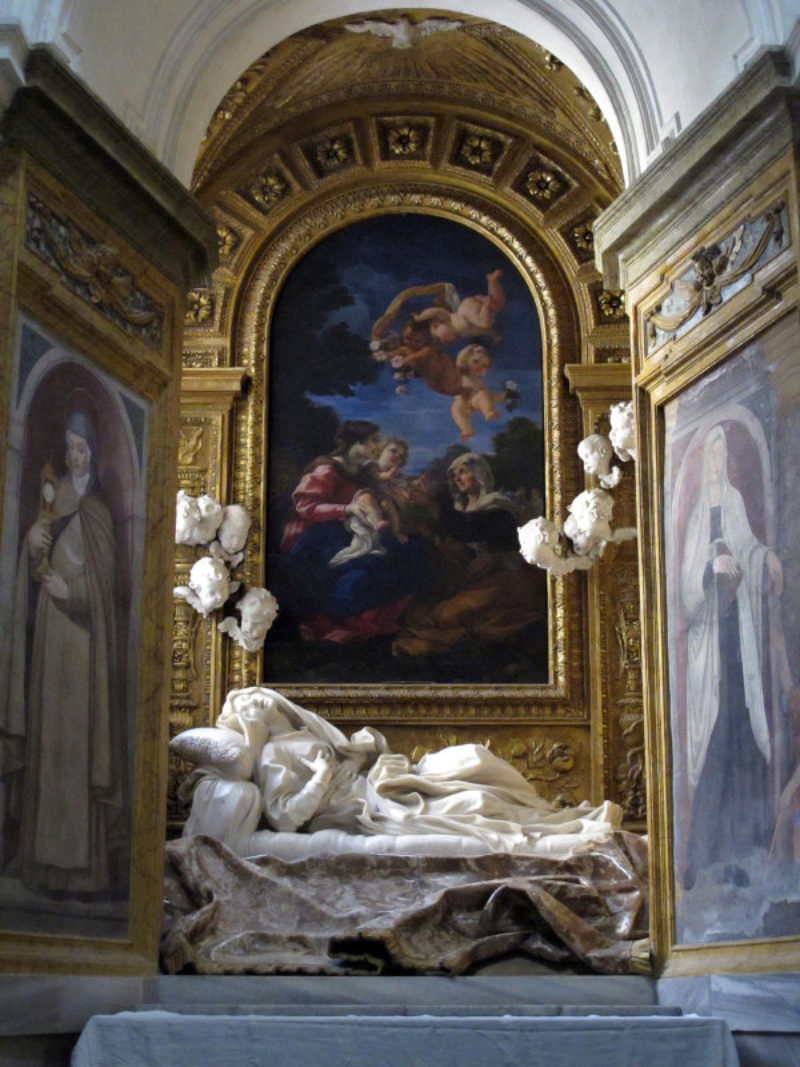
Blessed Ludovica Albertoni (1674) by Gian Lorenzo Bernini / Courtesy Wikipedia
The church of San Farncesco a Ripa originates from the 12th-century Franciscan convent in Trastevere district. Legend has it that the church housed Saint Francis during his visits to Rome. This site is less popular among tourists in Rome, though it also holds one of Bernini’s most striking sculptures, Blessed Ludovica Albertoni, completed in 1674.
Placed in the Capella Altieri or Paluzzi-Albertoni, the fourth chapel on the left, this sculpture is one of the latest examples of Bernini’s work. Ludovica Albertoni was a widow who became a Franciscan tertiary and was buried in the chapel in 1533 with her husband, after giving away her fortune to the poor. Stylistically, the sculpture follows the earlier example of Ecstasy of Saint Teresa at Santa Maria della Vittoria, depicting a saint in the moment of her spiritual unification with God. Her dress and the sheets, masterfully carved from marble, are rumpled and twisted, reflecting the emotional tension and drama of the moment. The effect of the mystical communion is emphasised by the natural light, entering through the hidden windows on the sides of the chapel and illuminating the figure of the saint.
The Baroque was one of the most prolific periods in the history of Italian art and its heritage is especially rich in Rome. If you would like to discover more masterpieces of the period, do not miss the Vatican with St. Peter’s square designed by Bernini, or visit the church of Santa Maria del Popolo to admire some of the many works by Caravaggio that are scattered around the city.
This article was originally published on Routes.Tips.